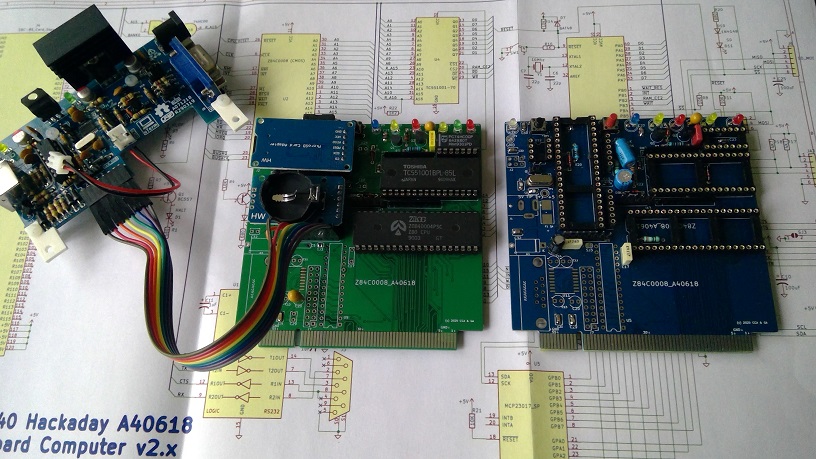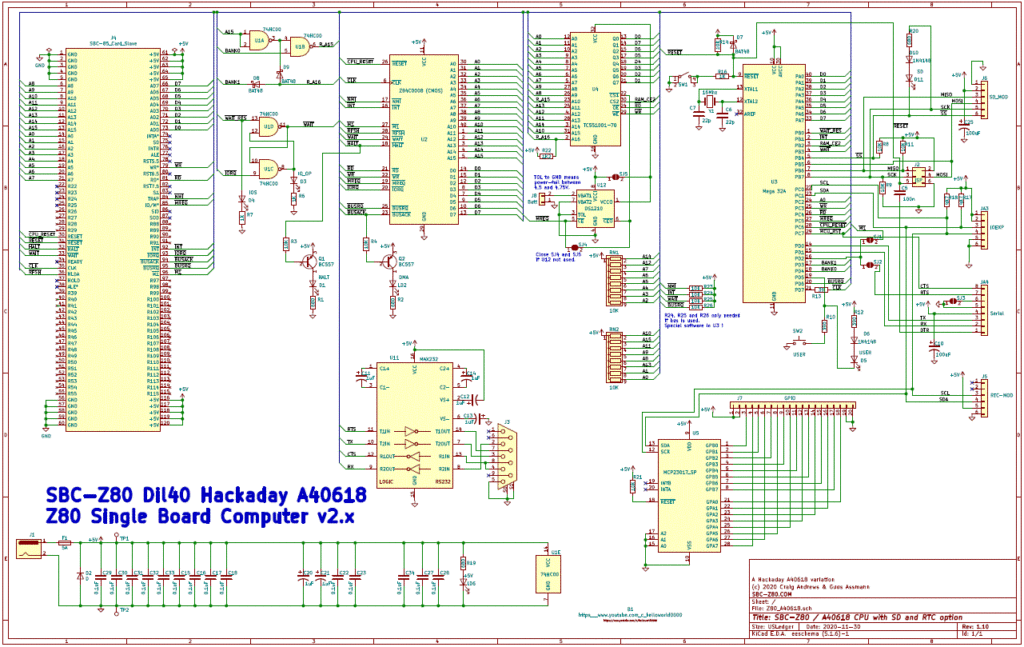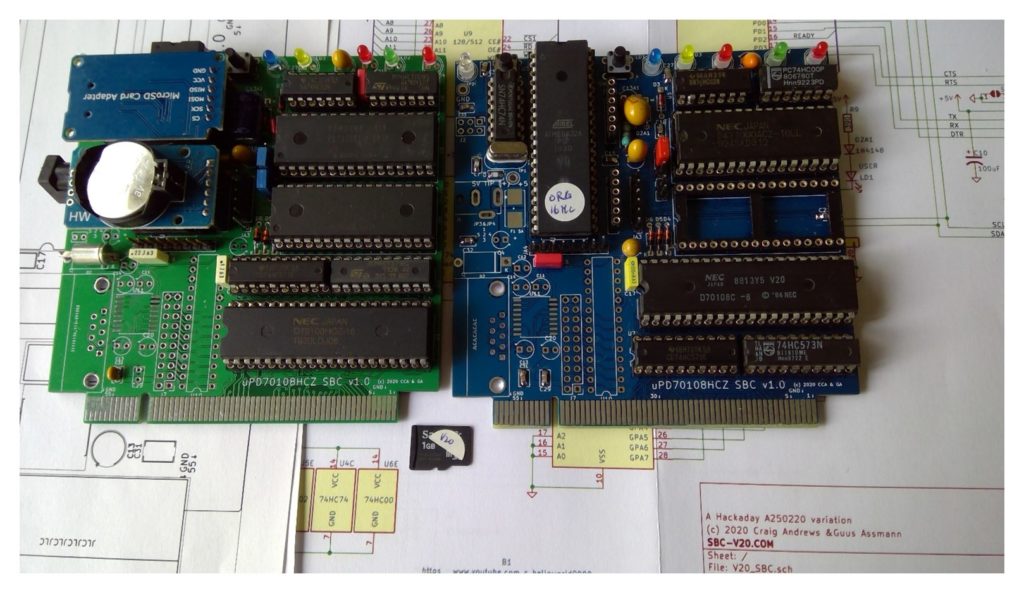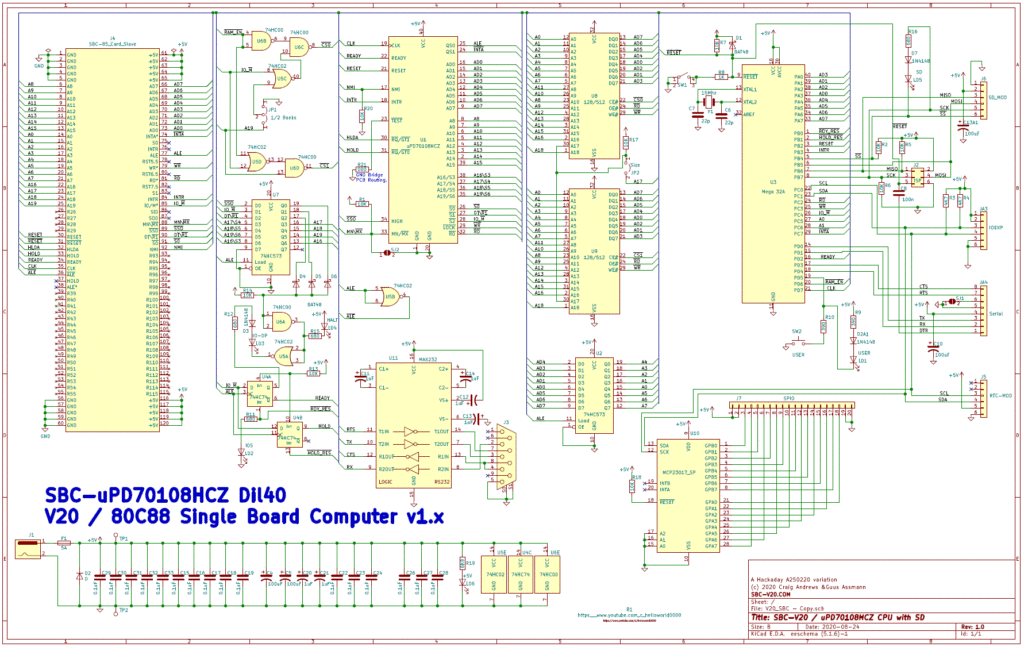Guus’ SBC-Z80 is built upon the just4fun @hackaday project 159973 Z80-MBC2: a 4 ICs homebrew Z80 computer applied to the SBC-85 backplane. Like the SBC-V20 project, an Atmel Mega32A microcontroller is the system workhorse providing ROM and I/O which includes an I2C port that communicates with a Microchip MCP23017 port expander.

The SBC-Z80 begins with the original SBC-85 backplane pinout and has further claimed a handful of previously unused pins HALT*, WAIT*, RFSH*, INT*, IORQ*, BUSACK*, and BUSRQ*). Like the original SBC-85 CPU board, the SBC-Z80 has a DB9 serial port with a MAX232 to generate true RS232 signal levels but it also brings off board the raw Mega32A signal levels for use with one of those handy TTL/CMOS to USB serial port adapters. Two of Guus’ completed boards are shown in the photograph, the one on the left has a micro SD and real time clock (via I2C) installed and a cable to a terminal board.

Primary components:
- Z80 CMOS CPU
- Atmel Mega 32A MCU
- 551001 (128KB) w/ DS1210 RAM controller
- MCP23017 port expander (I2C)
- MAX232 TTL / RS232 Level Shifter
I/O:
- SD Module with virtual disk capability
- Real Time clock Module
- 2x 8-bit I/O Expansion
- 115K RS232 Serial Port (with CMOS level header)
- ISP for programming the Mega32A
- 120 pin backplane (à la SBC-85)
Guus’s project package including the assembly manual, BOM, schematic, and KiCAD source files, and Gerber build files are available here (link). Software and more description is on Hackaday under the base design by just4fun @hackaday project Z80-MBC2: a 4 ICs homebrew Z80 computer (link). I will leave it up to Guus to let us know how compatible the SBC-V20 and SBC-Z80 boards are with the other SBC-85 expansion cards. For questions regarding Guus’ SBC-V20, leave a comment for Guus or send me an email on my contact page and I will forward it to him so you can communicate directly.
]]>Over the last year I received the occasional ping from Guus providing updates on his progress, but had not actually sat down to look over his accomplishments until now and, to say the least, I am incredibly impressed. This prolific engineer has created both V20 and Z80 single board computers based on the SBC-85 backplane as well as almost a dozen other boards, resident monitors, and support software. Fortunately for all of us, Guus has been gracious enough to share his design files for inclusion on the SBC-85.com site.
Guus’ SBC-V20 is built upon the just4fun @hackaday project V20-MBC: a V20 (8088 + 8080) CPU homebrew computer A170924 (link) as applied to the SBC-85 backplane. An Atmel Mega32A microcontroller is the system workhorse providing ROM and I/O which includes an I2C port that communicates with a Microchip MCP23017 port expander.

The SBC-V20 begins with the original SBC-85 backplane pinout and has further claimed a handful of previously unused pins (HLDA, HOLD, INTR, SSO*, DT/R1*, NMI, and S0*). Like the original SBC-85 CPU board, the SBC-V20 has a DB9 serial port with a MAX232 to generate true RS232 signal levels but it also brings off board the raw Mega32A signal levels for use with one of those handy TTL/CMOS to USB serial port adapters. Two of Guus’ completed boards are shown in the photograph, the one on the left has a micro SD and real time clock (via I2C) installed along with 1MB RAM, while the one on the right shows the board without the add-on modules and 128KB of RAM.

Primary components:
- uPD70108 CPU
- Atmel Mega 32A MCU
- 55100 (128KB) or 624006 (512KB) RAM
- MCP23017 port expander (I2C)
- MAX232 TTL / RS232 Level Shifter
I/O:
- SD Module with virtual disk capability
- Real Time clock Module
- 2x 8-bit I/O Expansion
- 115K RS232 Serial Port (with CMOS level header)
- ISP for programming the Mega32A
- 120 pin backplane (à la SBC-85)
Guus’s project package including the assembly manual, BOM, schematic, and KiCAD source files, and Gerber build files are available here (link). Software and more description is on Hackaday under the base design by just4fun @hackaday project A170924 (link) I will leave it up to Guus to let us know how compatible the SBC-V20 and SBC-Z80 boards are with the other SBC-85 expansion cards. For questions regarding Guus’ SBC-V20, leave a comment for Guus or send me an email on my contact page and I will forward it to him so you can communicate directly.
]]>










